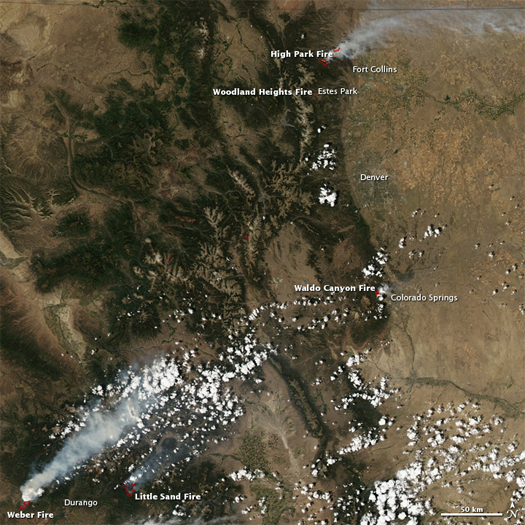
[Wildfires in the southern Rockies from space, June 23; via NASA Earth Observatory.]
A recent post on the current wildfires in the southern Rockies at the New York Times‘ Green blog reminded me that I had intended to excerpt an earlier editorial, also at the New York Times, which defended the notion of the Anthropocene as “the stage on which a new, more positive and forward-looking environmentalism can be built”:
Yes, we live in the Anthropocene — but that does not mean we inhabit an ecological hell. Our management and care of natural places and the millions of other species with which we share the planet could and should be improved. But we must do far more than just hold back the tide of change and build higher and stronger fences around the Arctic, the Himalayas and the other “relatively intact ecosystems,” as the scientists put it in their article.
We can accept the reality of humanity’s reshaping of the environment without giving up in despair. We can, and we should, consider actively moving species at risk of extinction from climate change. We can design ecosystems to maintain wildlife, filter water and sequester carbon. We can restore once magnificent ecosystems like Yellowstone and the Gulf of Mexico to new glories — but glories that still contain a heavy hand of man. We can fight sprawl and mindless development even as we cherish the exuberant nature that can increasingly be found in our own cities, from native gardens to green roofs. And we can do this even as we continue to fight for international agreements on limiting the greenhouses gases that are warming the planet.
The emphasis here (in the italics, which are mine) — on the possibility of designing novel ecosystems that perform better than the emergent novel ecosystems that will inevitably replace obsolete ecoystems unless we intervene — suggests a vast and unexploited territory for landscape architecture.
The post I mentioned earlier, on wildfire, brought this excerpt to mind for me because it describes the historical pattern of exactly one such obsolesence:
Using data from tree ring studies, scientists have reconstructed a history of fires in the Southwest. The wildfires of the past were frequent and massive, but they stayed close to the ground and mainly helped prevent overcrowding. Take 1748. “Every mountain range we studied in the region was burning that year,” Dr. Allen said. “But those were surface fires, not destroying the forest but just keeping an open setting.” Cyclical wildfires were the norm.
But beginning in 1900, when railroads enabled the spread of livestock, cattle devoured the grassy surface fuels and the fire cycle stopped. A decade later, a national policy of forest fire suppression formalized this new normal. Over the next century, forest density went from 80 trees per acre to more than 1,000.
Then in 1996, the climate emerged from a wet cycle into a dry one — part of a natural cycle for this region. Winters became drier. And “we immediately began seeing major fires,” Dr. Allen said.
With so many trees crammed into the forest, fires climbed straight to the canopy instead of remaining on the ground.
“These forests did not evolve with this type of fire,” said Dr. Allen. “Fire was a big deal in New Mexico, but it was a different kind of fire.” The result, he said, is that the species that now live there — ponderosa pines, piñon, juniper — cannot regenerate, and new species are moving in to take their place.
It seems quite noteworthy that the ecosystem which is becoming obsolescent — the dense conifer forest — is also a novel ecosystem of anthropogenic origin. The forest we are losing is as artificial as its replacement could ever be.
Dr. Allen’s final quote is also noteworthy, and would serve as a decent mantra for the environmentalist (or ecosystem-designing landscape architect) of the Anthropocene:
“Seeking to preserve existing systems is futile.”
[The authors of the editorial quoted above are Emma Marris, Peter Kareiva, Joseph Mascaro, and Erle C. Ellis.]


For more check out WiredScience
http://www.wired.com/wiredscience/2012/07/western-fire-transformation/
They talk with Donald Falk, a fire ecologist at the University of Arizona, pyrogeographer Jennifer Marlon of Yale University, forest ecologist Dan Binkley of Colorado State University and paleoecologist Erica Smithwick of Penn State University.
What is interesting is they all agree/indicate that the current/trending fire cycle doesn’t jive with historical ecosystems and emphasize the difficulty of predicting future successions.
Yet, there is this line at the end, “If people want to prevent the transformation, it’s still possible to do so through controlled burns and brush removal. ‘The pressures are very strong, but they’re not inevitable’.”
which seems to differ from the last quote you posted above from Dr. Allen.